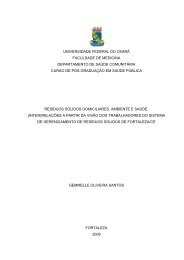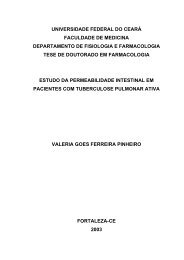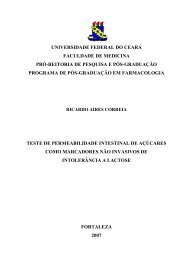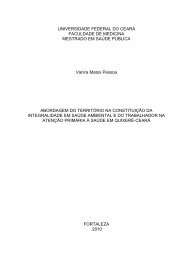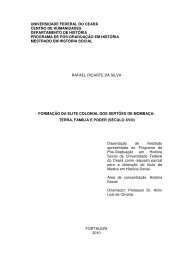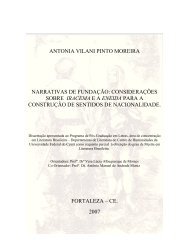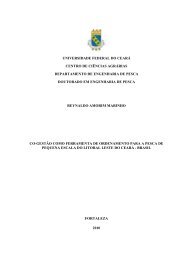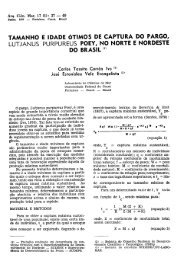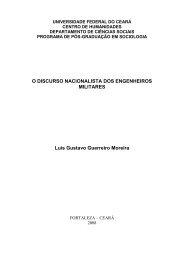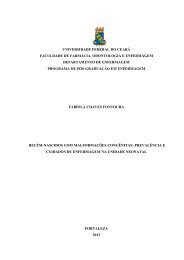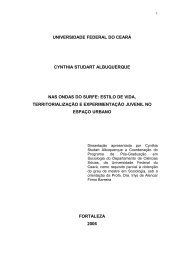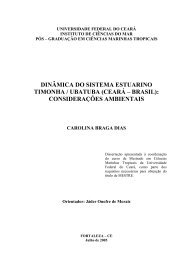Tungíase: doença negligenciada causando patologia grave
Tungíase: doença negligenciada causando patologia grave
Tungíase: doença negligenciada causando patologia grave
Create successful ePaper yourself
Turn your PDF publications into a flip-book with our unique Google optimized e-Paper software.
Heukelbach et al – Tungiasis in Alagoas State, Brazil<br />
known that a high exposure is correlated with a<br />
high parasite load [27], we assume that in Feliz<br />
Deserto exposure and transmission rates are low,<br />
as compared to the other endemic communities<br />
studied.<br />
Parasite load was disproportionately<br />
distributed with only few individuals harbouring a<br />
high number of lesions, whereas the majority had<br />
only one or two embedded sand fleas. In the dry<br />
season, only five individuals were responsible for<br />
17% of the total parasite load in the community.<br />
Similar patterns have been observed previously [6,<br />
9,11,15]. For example, in a fishing community, 8%<br />
of infested individuals accounted for 55% of the<br />
total parasite load in the community [9]. The rather<br />
few severely infested individuals may contribute<br />
disproportionately to the excretion of eggs by<br />
embedded sand fleas and therefore are<br />
responsible for maintaining transmission dynamics<br />
at a high level. Thus, identifying the most severely<br />
infested individuals in a community and focusing<br />
control on their households could be an efficient<br />
way to reduce transmission rates, as well as the<br />
degree of morbidity in an endemic area.<br />
In our study, the topographic distribution of<br />
sand flea lesions was similar to other previously<br />
published studies [6,9]: about 70% of individuals<br />
presented with lesions on periungual sites of the<br />
feet. Less than 5% of lesions occurred on ectopic<br />
sites, i.e. other topographic areas than the feet.<br />
The topographic distribution did not vary<br />
considerably between rainy and dry season,<br />
indicating that sand fleas prefer certain predilection<br />
sites, irrespective of environmental conditions. The<br />
number of ectopic lesions was lower, as compared<br />
to communities with higher prevalences in the<br />
general population. In these populations, lesions<br />
occurred on sites other than the feet in about 10%<br />
of cases [6,9]. As ectopic tungiasis is more<br />
common in individuals with a high parasite load<br />
[28], and because on the population level intensity<br />
of infestation is positively related to the<br />
prevalence, the occurrence of ectopic lesions<br />
could be used as a predictor for the prevalence of<br />
tungiasis in a community. As ectopic lesions, e.g.<br />
on the hands, are easily diagnosed, the presence<br />
of ectopic sand fleas may be useful as a rapid<br />
assessment method.<br />
In the study area, nail deformations were<br />
frequent. Nail deformation is the consequence of<br />
repeated infestation with or without secondary<br />
!<br />
"!#$%&'(!)&*&+,-.$/!0,1$(2.&3!"##$%!&'"()!"#"*"#+,<br />
infection. Nail deformation occurred in about 27%<br />
of cases. Severe sequels, such as difficulty<br />
walking and deformation of digits due to severe<br />
infestation existed, but were less common. This<br />
confirms the notion that tungiasis cannot be<br />
regarded as nuisance, but as an important health<br />
problem [6,16,29]. In Haiti, deaths were reported<br />
as a result of severe infestations, probably due to<br />
septicaemia and tetanus [7]. In rural Nigeria,<br />
difficulty walking occurred in 32%, deformation of<br />
toe-nails in 27%, and loss of toe-nails in 16% of<br />
the patients [6]. Between 20% and 29% of<br />
individuals infested with tungiasis stated that they<br />
woke up at night due to itching at the site of<br />
penetration. Itching has been repeatedly described<br />
as a predominant symptom of tungiasis [6,29,30].<br />
However, other parasitic skin diseases, such as<br />
cutaneous larva migrans and scabies, are endemic<br />
in the study area [31,32], and polyparasitism may<br />
have occurred. Thus it is possible that these<br />
diseases also caused sleep disturbances in some<br />
individuals with tungiasis.<br />
Our data show that the prevalence of tungiasis<br />
was significantly higher in the dry than in the rainy<br />
season. The difference was less pronounced than<br />
the seasonal variation observed in the only<br />
longitudinal study published so far [24]. Similar to<br />
our findings, in the latter study the highest<br />
prevalence was found in an urban slum in Brazil in<br />
the middle of the dry season. Prevalence differed<br />
by more than a factor three throughout the year<br />
(54% vs. 17%), and was clearly correlated to<br />
precipitation patterns [24]. Interestingly, in our<br />
study, in adults aged 20 to 59 years prevalence<br />
was twice as high in the dry season, as compared<br />
to the rainy season. This indicates that attack rates<br />
actually increased in the dry season. Seasonal<br />
variation of attack rates and incidence probably is<br />
caused by biological dynamics of the sand flea<br />
population, reflecting changes of environmental<br />
variables. During the rainy season, high soil<br />
humidity may impair the development of free-living<br />
stages of sand fleas, and heavy precipitations will<br />
wash away eggs, larvae, pupae, and adult stages<br />
from the area where they developed [24].<br />
The varying incidence of T. penetrans during<br />
the year is a good explanation for the highly<br />
diverging prevalences observed in previous<br />
population-based studies. In fact, studies were<br />
performed in different seasons, and sometimes<br />
over a prolonged period of the year; and often<br />
207



